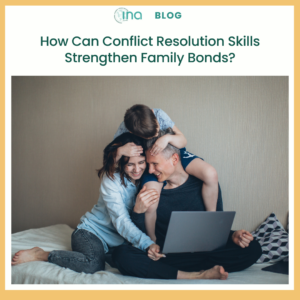Effective conflict resolution is one of the top skills many companies seek to hone, but it is also vital in one’s personal or family life. One study found that family conflict at age six was linked to increased withdrawn-depressive symptoms in children two years down the track. Exposure to negatively handled conflict is also linked to having a higher risk of anxiety and mood issues. Conflict does not always have to be a negative thing. It is a natural occurrence among people, who need to work out how to achieve their wants and needs while also respecting that others may have conflicting wants and needs. When handled positively, conflict can actually be a wonderful catalyst for change and a way to help family members understand each other more deeply.
Conflict and Attachment Styles
In order to handle conflicts with family members, it is important to know ourselves. Interestingly, conflicts themselves provide us with rich ground upon which to learn more about our triggers, ways of processing them, and our ensuing behaviors. Much of the current theory about family relationships and conflict patterns can be traced back to Attachment Theory, which was first developed by the psychologists, John Bowlby and Mary Ainsworth. People form patterns of attachment, which are related to the relationships they had with their caregivers during their infancy and early childhood. People with insecure attachment styles can indulge in unhealthy behaviors such as forcing reconciliation too early, withdrawal, or aggression. They may find it hard to maintain their cool during conflict. Those with a secure style, on the other hand, are more likely to see conflicts as a means to a greater understanding of their loved ones.
Conflict as a Means to Greater Self-Knowledge
Through conflicts, self-analysis, and in some cases, therapy, one can learn more about how attachment affects one’s behavior during conflicts. For instance, people with avoidant styles may distance themselves (escape or ghost others) during conflicts. Those with anxious styles, meanwhile, may be the “pursuer”—in other words, they may seek closeness and aim to solve the conflict immediately, sometimes repressing their own needs or failing to give another family member the temporary space they need. Effective conflict resolution involves focusing on oneself and on making changes that can improve the outcomes of family conflicts instead of trying to change others. For instance, a pursuer may resolve to give others a bit of distance and get back to a discussion at a better time. A distancer, meanwhile, may commit to taking part in active listening and other behaviors that can foster true understanding instead of escape or withdrawal.
Creating Ground Rules
As well as working on oneself, families can sharpen their conflict resolution skills by laying ground rules. One of the most important aspects of getting along well is to respect each other’s boundaries. This includes intellectual, physical, and spiritual boundaries. For instance, in some families, members can differ concerning their spiritual or political opinions. Members can agree to avoid politics in family get-togethers; indeed, they can freely make a list of topics that all parties concerned agree can cause unnecessary strife. In the case of politics, doing so makes sense, since studies show that politics is a more divisive topic today than ever. Family members can avoid this type of conflict. Of course, this does not mean repressing one’s thoughts and emotions. Important matters that can potentially cause conflict (such as the equitable distribution of chores, finances, and ideas on educating kids) need to be addressed. The key is to rely on optimal communication skills when talking about these topics.
Conflict Resolution Skills to Embrace
Family members can agree to employ good communication skills like active listening. This means listening with all of your senses and being present. This helps you understand what the other person is thinking and feeling. It extends to using “I” language in phrases such as, “When you_____, I feel…” instead of language such as “You always/never” (which puts the other person on the defensive). Family members should aim to express their empathy and understanding by paraphrasing what their loved ones are saying. Finally, all members should take a problem-solving approach. This involves identifying a problem, suggesting solutions, and choosing the option that most closely fits everyone’s needs.
All families have conflicts. It’s how they repair them that matters. Doing so involves agreeing on behaviors that promote understanding—including active listening, empathy, and embracing a solutions-based approach.

